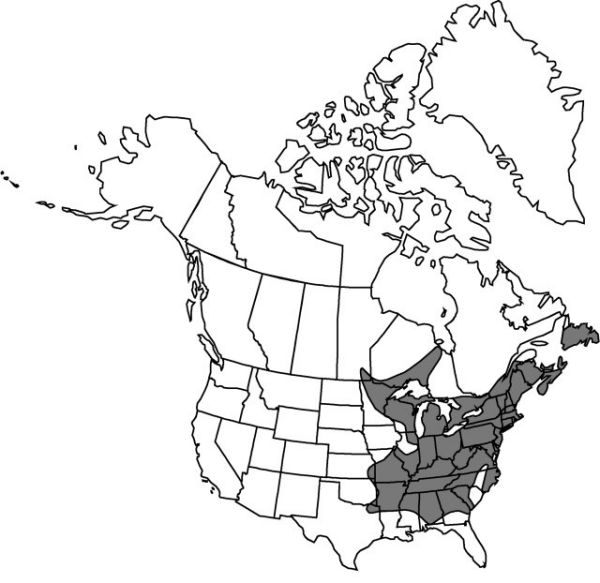Platanthera lacera
in R. Sweet, Hort. Brit. ed. 3 650. 189.
Plants 14–80 cm. Leaves 1–4, wide-spreading to ascending, scattered along stem, gradually to abruptly reduced to bracts distally; blade linear-lanceolate, linear-oblong, or oblong-obovate, 7–23 × 0.7–5 cm. Spikes lax to dense. Flowers resupinate, not showy to inconspicuous, whitish green or yellowish green, lip often paler; lateral sepals reflexed; petals linear to narrowly oblong-spatulate, margins entire or apex rarely slightly lacerate; lip descending, without basal thickening, deeply 3-lobed, 10–17 × 13–17 mm, lobes extensively and deeply divided, commonly into filiform divisions, margins rarely merely fringed or middle lobe merely lacerate-fringed, lateral lobes narrowly to broadly cuneate, middle lobe cuneate-flabellate, usually narrow; spur slenderly to markedly clavate, 11–23 mm; rostellum lobes nearly parallel, directed downward, short, rounded; pollinaria nearly straight; pollinia remaining enclosed in anther sacs; viscidia linear; ovary slender to stout, mostly 8–20 mm. 2n = 42.
Phenology: Flowering May–Aug.
Habitat: Sphagnum bogs, alluvial and swamp forests, stream banks, riparian meadows, sand flats, moist and seeping slopes, prairies, roadside banks, ditches, old fields, borrow pits
Elevation: 0–1200 m
Distribution

Man., N.B., Nfld. and Labr. (Nfld.), N.S., Ont., P.E.I., Que., Ala., Ark., Conn., Del., D.C., Ill., Ind., Kans., Ky., Maine, Md., Mass., Mich., Minn., Miss., Mo., N.H., N.J., N.Y., N.C., Ohio, Okla., Pa., R.I., S.C., Tex., Vt., Va., W.Va., Wis.
Discussion
Hybrids with Platanthera grandiflora (P. ×keenanii P. M. Brown; see note under 20. P. grandiflora) and P. psycodes [P. ×andrewsii (M. White) Luer] are variably intermediate between the parents, with various purple-green shadings and lobes of the lip generally narrower and more dissected than in the purple-flowered parents. The linear viscidia of P. lacera and the large anther sacs of P. grandiflora provide means for determination. The ratio of viscidium length/width of 1–3.2 distinguishes hybrids and purple-flowered parents from P. lacera, which is characterized by a ratio of 2.7–4.6. The parentage of hybrids can be determined by different sized anther sacs: P. ×andrewsii, 1.4–2.3 mm; P. ×keenanii, 2.5–4.2 mm. Those hybrids can be distinguished from their purple-flowered parents by less intense coloring and the ratio of viscidium length/width: P. psycodes 1–1.5; P. ×andrewsii, 1.3–3; P. grandiflora, 1–1.5; P. ×keenanii, 1.5–3.2. The plants known as Platanthera lacera var. terrae-novae (Fernald) Luer (Habenaria lacera var. terrae-novae Fernald) apparently represent swarms of P. ×andrewsii and introgressed P. lacera (P. M. Catling and V. R. Catling 1994).